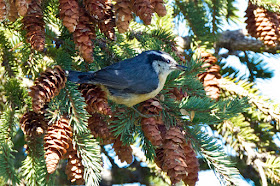There was a confusing mix of warblers passing through
Wisconsin recently. Many were so similar
in appearance that only the experienced birder could identify them on the
wing.
But two warblers that are relatively easy to pick out of the
flock are the American Redstart...
...and the Black-and-White Warbler.
This female American Redstart passed over Wisconsin a month
ago. You can still see green
leaves on the trees. There are occasional reports of new sightings of American
Redstarts, but the migration is slowing.
I was waiting for my chance to photograph a male during this fall’s
migration, but I couldn’t find one.
This female put on quite a show for me though, flitting in
the understory at eye level and slightly above, showing off her bright yellow
tail patches and inviting investigation.
She wasn’t shy! The male,
which I never found, is black where the female is grey and orange where she is
yellow.
The Black-and-White Warbler is well named. Heavily striped in black and white, it
is hard to come up with a better name for it. Unusually aggressive for a warbler, it will fight when
necessary. Equipped with a longer
rear toe and claw for foraging in the trees, mostly it searches for insects,
upside down and sideways.
Allan

























